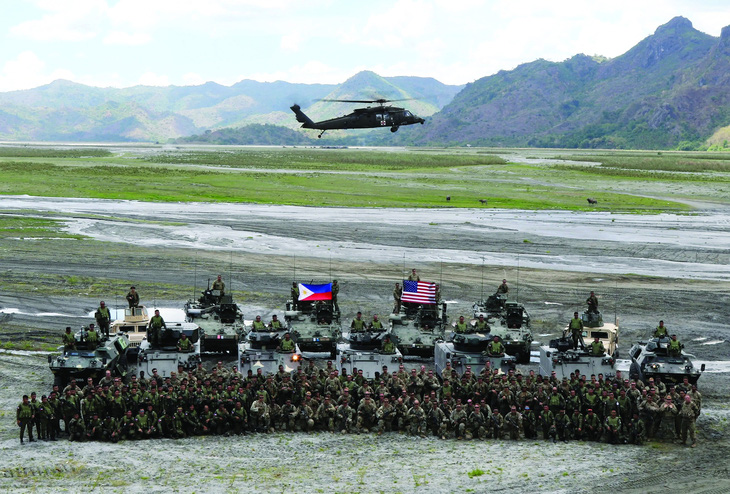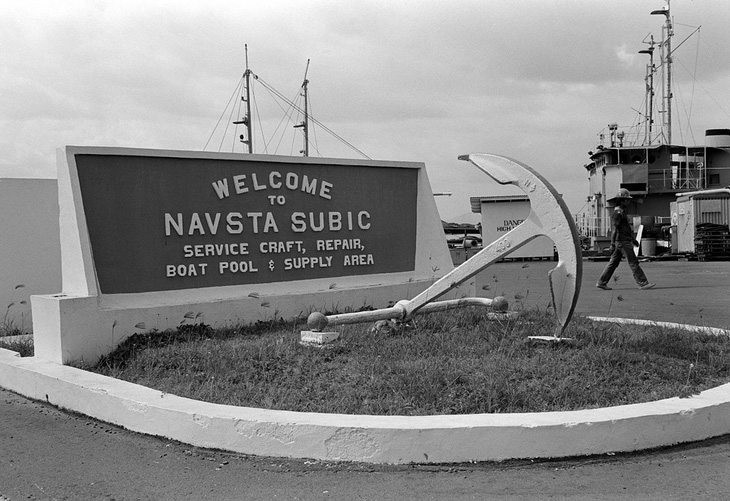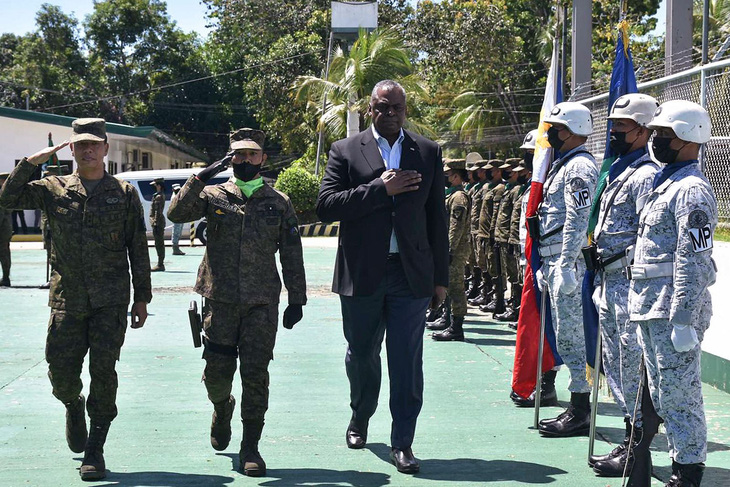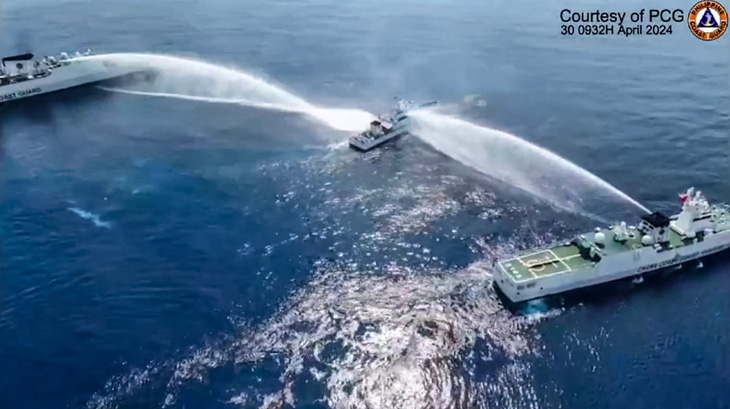TTCT – Since April 22, more than 16,000 Philippine and American soldiers have participated in the Balikatan exercise with the participation of a French naval warship for the first time.
Balikatan exercise takes place annually. Photo: Wikipedia
This year’s Balikatan (meaning “Shoulder to Shoulder”) exercise, the 39th, includes a series of complex maneuvers in maritime security, identification and targeting, air and missile defense, missile attack initiative, cyber defense and information operations… All reflect the concerns of the military in the new situation after Russia’s war in Ukraine.
The Consequences of Treaty and No Treaty
The exercises also demonstrate the long-standing alliance between the United States and the Philippines, which were bound together by the Mutual Defense Treaty (MDT) signed in 1951. Accordingly, “the Parties shall assist and support each other, maintain and develop their individual and collective capabilities to resist armed attack” (Article 2).
This alliance of course has a long history, dating back to the time when the Philippines was an American colony, and then to World War II, when US Marines landed to drive out the occupying Imperial (Japanese) army. The 60-hectare US military cemetery on the outskirts of Manila, with 16,859 graves, is an illustration of this closeness.
The unique feature of the MDT is that the assessment of the situation is not made by the Ministry of Defense or military officials, but by foreign ministers:
“The Parties, through their foreign ministers or their deputies, shall consult each other from time to time regarding the implementation of the treaty whenever either Party considers that its territorial integrity, political independence or security is threatened by external attack in the Pacific” (Article 3).
Of course, the first decision of both sides is to report to the United Nations Security Council (Article 4), not to “take action” arbitrarily.
In fact, since the Philippines’ liberation from Japanese militarism, the two sides signed in 1947 the Military Bases Agreement (MBA), which was revised in 1966 to cut the US military presence to 25 years, expiring in 1991, and should have been renewed.
However, on September 16, 1991, 12 Philippine lawmakers made history when they voted not to renew. They argued that leasing the base would mean losing sovereignty, and the rent offered by the US, $203 million a year, was not worth it.
Furthermore, the eruption of Mount Pinatubo in mid-June 1991 – ash drifted all the way to Vietnam – gave the US reason to abandon Clark Air Base and Subic Naval Base.
Subic Bay Base. Photo taken in 1983. Photo: Wikipedia
The fact that the Philippine Senate, not the US Senate, initiated the legislative process to expel the US military in late 1991 led to some serious consequences, most notably the Chinese occupation of Mischief Reef in 1995.
This argument was made by former Philippine Defense Secretary Delfin N. Lorenzana himself in an article commemorating the 70th anniversary of the MDT: “The weakness of the Philippines’ defense capabilities was clearly exposed when the US bases closed in 1992.
With the closure of the US bases, the supply of spare parts to maintain equipment dried up and a large number of ships, planes, helicopters, and trucks were no longer operational. It is no coincidence that China took control of Mischief Reef in 1995, just three years after the (US) bases closed.”
A tumultuous relationship
Realizing the problem, the Philippines and the US discussed and approved the Visiting Forces Agreement (VFA) signed on May 27, 1999. This agreement created a legal basis for US soldiers to come to the Philippines for exercises and temporary stationing.
In 2014, the US and the Philippines signed an Enhanced Defense Cooperation Agreement (EDCA), which allows US troops to visit Philippine bases and strategic locations for joint training and to build infrastructure such as runways, fuel storage facilities and housing. (The EDCA was expanded in 2023, allowing the US access to nine locations, up from five previously.)
But bilateral relations became strained after the 2016 Philippine presidential election, which saw the election of Rodrigo Duterte. Duterte began his term with a visit to China in October 2016, expressing his desire to “pivot.”
In Beijing, he declared to an audience that included leaders of many of China’s largest businesses: “America has lost… I have put myself back in your line of thought.”
Leaving Beijing, Mr. Duterte brought back to Manila commitments worth $24 billion under the Belt and Road Initiative. (Unfortunately, according to the Philippine National Economic Development Authority, only a very small portion of the commitments have been implemented in practice, according to Reuters November 29, 2023).
Mr Duterte’s “separation” from the US came to a head in early 2020 after the US revoked the visa of Senator Ronald “Bato” de la Rosa, who led Mr Duterte’s war on drugs as national police chief.
In February 2020, Mr. Duterte informed Washington of his intention to terminate the VFA within 180 days. However, the Covid-19 pandemic forced him to “turn around” again. During a meeting with US Secretary of Defense Lloyd Austin on July 30, 2021, at the height of the pandemic, Mr. Duterte said he was willing to fully restore the VFA on the condition that the US provided vaccines.
Ultimately, as of March 2022, the US has provided the Philippines with $38 million in cash and 32 million doses of vaccine (out of a total of 69 million doses under the Covax Facility).
The US-Philippines relationship, therefore, is like a “love affair across the centuries”, full of joy, anger, love, hate and ups and downs.
US Secretary of Defense Lloyd Austin (in suit) during a visit to the Philippines. Photo: Getty
ASEAN: Unsuccessful efforts to unite
To be fair, there was a good reason why half the Philippine Senate in 1991 was so eager to end the Military Bases Agreement with the United States. There was nothing wrong with raising the flag of independence.
Leszek Buszynski, author of the study “Realism, Institutionalism, and Philippine Security,” asks: “Can a state entrust its security to a multilateral security institution?”
According to the author, this is truly a matter of survival for many countries facing a dilemma: should they rely on traditional defense and security views, forming alliances and balancing; or should they move towards multilateral institutions, emphasizing dialogue and preventive diplomacy.
The author studied the case of opposition lawmakers and intellectuals in the Philippines who opposed US bases in the country. In their discussions, they often assumed that after the Cold War, US military bases were no longer necessary in an environment where there was no longer a direct threat to national security.
They accuse the administration of using the security pretext to justify the US presence or of bowing to US pressure.
Then-Philippine Senate President Jovito Salonga laid out a strategic vision of a country without US bases, calling for the realization of the ASEAN-proposed Zone of Peace, Freedom and Neutrality (ZOPFAN).
Senator Juan Ponce Enrile wanted to end the military alliance with the United States and sign non-aggression pacts with China, Japan, the Soviet Union and other neighboring countries.
Fidel Ramos, then president of the Philippines, also called on ASEAN to take on a role in preventing conflicts in the South China Sea, asserting that “the balance of political and economic power within [ASEAN] is sufficient to ensure general peace and stability.”
But Buszynzki’s study concludes: “The Philippines’ efforts to rally support from regional institutions over the Mischief Reef incident, in ASEAN and the ASEAN Regional Forum (ARF), are a test for these organizations.”
Two Chinese ships sprayed water cannons at a Philippine vessel in the latest incident between the two countries near Scarborough Shoal. Photo: Philippines Coast Guard
At that time, it was not only the Philippines that believed in the power of ASEAN. In a post-Cold War spirit of euphoria, Malaysian Foreign Minister Abdullah Ahmed Badawi declared that security could no longer be assured “by the old deterrent method of countervailing force”; instead, “our security and prosperity will have to be shared through enhanced cooperation, transparency and understanding.”
On that basis, ASEAN foreign ministers inaugurated the ARF, first held in Bangkok in July 1994 as a security forum, consisting of 18 members.
But from the beginning there were disagreements about the function and role of the ARF. From the perspective of the United States, Canada and Australia, the ARF should contribute to resolving current conflicts in the Asia-Pacific with a formal structure.
But China, concerned that it would become a target if that happened, has stressed that the ARF should focus on discussion rather than arbitration or conflict resolution.
Ultimately, the struggles have made the “neutral, dialogue” stance increasingly unrealistic, and a true ASEAN security mechanism has failed to form, after many meetings at all levels over the years.
The undeniable reality is that the current regional security situation is not significantly better than it was more than 30 years ago, when the Philippines terminated its defense agreement with the United States. Hot spots of potential conflict remain, and have even become more intense.
Many new security threats have emerged, requiring major actors to act on their own and raising inevitable questions about the nature of “self-defense” and alliances.
All this shows that a small country should not necessarily tie itself to only one traditional alliance, based on old favors, once the situation has changed. ■









